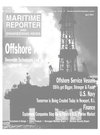
Faster Than A Speeding...
It is little secret that as offshore oil production moves further from shore, the boats that service these offshore units must be bigger, stronger and more capable than their ancestors.
Here's a peak at emerging technologies and the boats that house them.
big find,' and now that many of the complexities have been largely solved, namely the ability to accurately project volume of product at such great depths — orders for new, more capable vessels in ever increasing numbers.
The technology to cost efficiently discover and recover oil and gas in increasingly deeper part of the Gulf of Mexico has quickly led to the development of bigger, stronger and more ruggedly equipped Offshore Service Vessels, not only on drawings boards but operating on the waterways. The discovery of oil and gas fields such as Auger, Marlim and Mars, have among others, highlighted the vast potential for drilling success and the inadequacy of the current fleet of OSVs to perform the job as cost effectively as possible.
The oil companies have invested billions in efforts to discover the 'next One of the more notable vessels delivered in the last six months is BJ Blue Ray, a vessel built by Leevac Shipyards LLC, and delivered to Hornbeck. The vessel had been chartered to BJ Services, Houston, Texas, and finished as a well stimulation vessel.
Measuring 265 x 60 ft. (80.7 x 18.2 m) with a 22-ft. (6.7-m) hull depth, the vessel's mass and design allow it to work in higher seas, while providing impressive tankage below deck. A common feature of the Hornbeck vessels is Dynamic Positioned (DP) navigation systems. Dynamic positioning was first developed to help keep drill ships precisely over the well they were drilling regardless of wind and sea state. All of the recently built Hornbeck vessels have DP-2 capability that calls for independent bow and stern thrusters each driven by a separate power source. Vessel positioning variables such as wind, and sea state are fed into a central comput- er that feeds information to the main engines and the thrusters to keep the vessel on station and can do so even if there is a single point failure on one of the thrusters or main engines.
Other stories from April 2002 issue
Content
- U.S., Spain Team To Develop New Warship page: 4
- Bennis to Lead Maritime, Land Security page: 4
- Halmatic To Supply RIBs For Maritime & Coastguard Agency page: 8
- Germanischer Lloyd Reorganizes Operations page: 11
- Celebrity Cancels Summit And Infinity Sailings page: 11
- Kvaerner And Aker Maritime Join Forces page: 12
- Royal Caribbean And Celebrity Announce Key Appointments page: 13
- Key Port Security Measure Passed page: 16
- Boston Whaler Unveils "Robot" Security Boat page: 18
- Protection Zones In Place For USS Roosevelt's Return page: 19
- DOT Outlines Smart Card Concept For Transportation Workers page: 20
- I MO Calls for Unity on Bulk Carrier Safety page: 22
- OECD Working Group To Brainstorm on Port Security page: 22
- NWDC: The Ultimate One-Stog Shop page: 24
- Boston Whaler Debuts New Security Products page: 26
- No Substitute for A Strong Navy page: 28
- HSV Gets Marines There Faster page: 33
- Information: The Real Power page: 33
- GE Continues To Set Gas Turbine Tech Pace page: 34
- Vericor Is A Reliable Source of Propulsion Power page: 35
- The Allure of Power page: 36
- Spanish Group Endorses Pentamaran page: 37
- industrial Heritage Is Retained page: 38
- MES Completes the World's Largest Diesel Engine page: 39
- Faster Than A Speeding... page: 40
- The Rolls-Royce Design Solution page: 41
- Jane Tide Makes An Impact page: 41
- Halliburton Brings Viking To GOM page: 42
- ABS Speeds Truss Spar Projects to GOM page: 42
- Bollinger Signs Contract For Supply Boat Trio page: 43
- As Banks Step Down, Equipment Finance Companies Step Up page: 44
- Cummins Inc. And CitiCapital Launch Alliance page: 46
- ACR — On The Road To Safety And Survival Technology page: 48
- New Service Frees Ships From Hostile Situations page: 49
- Positive Outlook for Global Subsea Development, Deepwater Strengthening page: 50
- A World of Controversy page: 64
- INTERTANKO Holds Firm Position o n M a r i t i m e security page: 66
- North Mariner — In A Class of Its Own page: 68
- Volvo Penta Engines In Clean Design Ferry page: 69
- Hernis 400 System Is Safe And Sound page: 69
- The Dash for Gas page: 74
- BP's Discovery Is Re-Named Thunder Horse page: 75
- Crowley Moves ExxonMobil Concrete Island Drilling page: 76
- Dresser-Rand Equips Petrobras FPSO page: 76
- Transas Launches LNG Tanker Simulator page: 76

